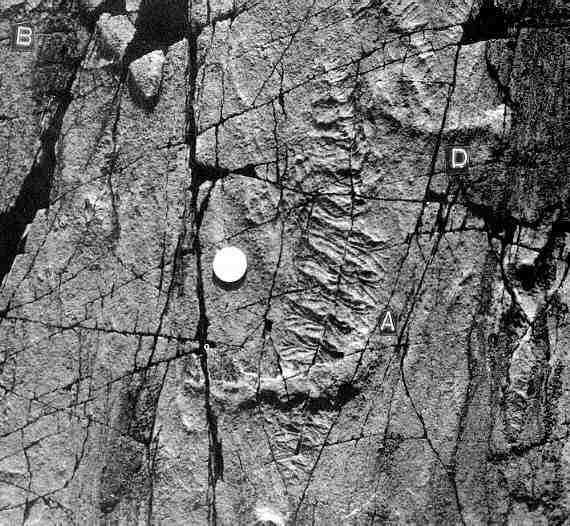
Fractofusus, vintage 600 million years ago give or take. Salp ancestors? Shark tooth kebabs? Early Surf-board Peeps(TM)? If you can figure out what the heck this is, you get a gold star -- and a paper in Nature! Photo by Dr. S.B. Misra
No time for a long post tonight or likely over the weekend, but just wanted to give you guys a heads-up on a don’t-miss article. The grand story of life on Earth has a rather extended bacterial prologue (or a fairly short multicellular epilogue, depending on how you look at it). In fact, the story of bacteria is almost the story of the entire book. Multicellular life only came along in the last 600 million years or so, and life is posited to have existed on Earth almost since its formation 4.6 <pinky to mouth>billion</pinky to mouth> years ago, and certainly since at least 4 billion years ago (doing the math, that means bacteria have been around 8 times longer than us “higher” organisms).
Anywho, one of the Big Questions is why it took so long for multicellular life to show up, and once it did, why the first draft was *so frickin’ weird* compared to what exists today. The Ediacaran fauna is that first draft, and it bears little resemblance to the life that came afterward in the Cambrian Explosion. You’ve heard me mention the Ediacaran fauna before, notably on my visit to the Sant Ocean Hall last fall in which I was utterly ecstatic to get to see some of the original Ediacaran fossils in person. This article in the New York Times tackles scientists’ current thinking on the Big Questions — and has a lovely slide show that helps explain why I get so excited about Ediacara (only disadvantage: no scale bars. Some of these guys are way smaller than photos would leave you to believe — and some are larger).
Even I was stunned to discover a few fossils in the show I’d never seen before — particularly Fractofusus, above. I had a big WOW moment when I saw it. By far, it is the most beautiful Ediacaran I’ve seen. It comes from an Ediacaran locality I hadn’t been aware of previously: the gloriously named “Mistaken Point” on the south shore of Newfoundland. The photo above doesn’t quite do justice to the photo in the NYT slideshow, so make sure you check it out.
What the heck was it? How was it making a living? What did it look like in real life? Was it brightly colored? Was it an evolutionary dead end or is it a secret ancestor of some totally common form today? If secret ancestor, was it of plant, animal, or “other”? If only, if only, if only I could climb in a phone booth time machine with Keanu and So-crates and take a peak in those early oceans(ok, that’s multicellularist. Late oceans.). That would be most excellent.


{ 1 trackback }
{ 8 comments… read them below or add one }
I think the Sant Ocean pics are missing from your server. A random sampling of other older
articles(pre November 09) suggests that other “local” images are also missing. Perhaps an
oversight when changing servers?
It would be appropriate if you mention the source of the photograph above.
To the best of my ability, I did, sir. I linked the photo to the place I got it from (this page at wikipedia) and cited the license (Creative Commons) and the image’s author (Mistakenpoint) according to that page. If that person made an error or gave incorrect or false information, I apologize, but I did my best given the information I had. If it is your photo instead and you would prefer it to be removed or re-attributed, please do let me know. I am happy to oblige. Best wishes — Jen
Duly noted! I will work on the issue next week. I think you are right that it had to do with changing servers.
Hi Janifer,
Thanks for prompt acknowledgement. Please let me know if I could be of any academic assistance.
Best Wishes,
S. B. Misra
Hi Jennifer,
I did not comment by way of complaint. I will be happy if it is duly acknowledged. May be the source you took it from had made an error. For original reference please see my paper ‘Late Precambrian (?) Fossils from Southeastern, Newfoundland” published in the Geological Society of America Bulletin, Vol.80, p. 2133-2140 of 1969 and the photograph is part of Plate 3 in the paper. The photograph is available on the webpage: Mistaken Point Fauna: The Discovery. In any case, I am sorry if I sound like complaining.
Best Wishes,
S. B. Misra
Hi Dr. Misra,
No offense taken! I just wanted to let you know I did try my best. : ) I will update the credit to reflect the photo’s true source. Thanks so much for letting me know. Jennifer
Hi Jennifer,
Thank you. I am happy you did not take my comment otherwise and made necessary change. Please feel free to make use of any of my material with acknowledgements.
Best Wishes,
S. B. Misra